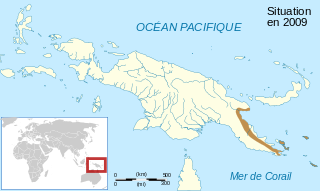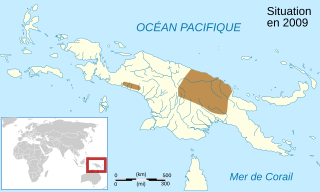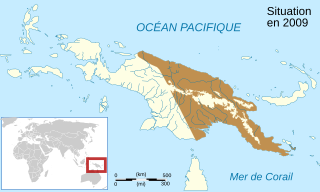Austrochaperina adamantina is a species of frog in the family Microhylidae. It is endemic to New Guinea and occurs in the Torricelli and Bewani Mountains in the West Sepik Province, Papua New Guinea. The specific name adamantina is Latin for "like a diamond" and refers to Jared Diamond, credited as the collector of the holotype and "great many other valuable herpetological specimens from Papua New Guinea".

Austrochaperina aquilonia is a species of frogs in the family Microhylidae. It is endemic to the Sandaun Province, north-western Papua New Guinea. It is only known from two nearby locations in the Torricelli Mountains: Mount Somoro and from the village of Wilbeite. The specific name aquilonia is a Latin adjective meaning "northern" and refers to the range of this species in the north coast mountains of New Guinea.
Austrochaperina basipalmata is a species of frog in the family Microhylidae. It is endemic to the mountain ranges of northern New Guinea and is found between Tawarin River in Papua, Western New Guinea (Indonesia) and Torricelli Mountains in Papua New Guinea.
Austrochaperina blumi is a species of frog in the family Microhylidae. It is endemic to New Guinea and known from the northern slopes of the New Guinean Central Range in Western New Guinea (Indonesia), and from the Bewani, Torricelli, and Hunstein Mountains in Papua New Guinea. The specific name blumi honors J. Paul Blum, the herpetologist who collected the type series. Common name Kosarek land frog has been proposed for it.
Austrochaperina brevipes is a species of frog in the family Microhylidae. It is endemic to Papua New Guinea and known only from two localities, Mount Victoria and Myola Guest House in the Owen Stanley Range. Common name Victoria land frog has been suggested for it.

Austrochaperina kosarek is a species of frog in the family Microhylidae. It is endemic to New Guinea and only known from its type locality, Kosarek, in West Papua (Indonesia). It is only known from one specimen collected in 1979. It has not been well-studied but it might be widespread in suitable habitat.

Choerophryne allisoni is a tiny species of frog in the family Microhylidae. It is endemic to Papua New Guinea and only known from its type locality, Mount Sisa in the Southern Highlands Province. The specific name allisoni honours Allen Allison, an American herpetologist. Common name Allison's mountain frog has been coined for this species.
Copiula obsti is a species of frog in the family Microhylidae. It is endemic to the Wondiwoi Mountains in West Papua, Indonesian New Guinea. It is known mature forest at elevations of 400–800 m (1,300–2,600 ft) above sea level. It lives under leaf litter on the forest floor. It is potentially threatened by habitat loss caused by logging.

Sphenophryne thomsoni, sometimes known as Thomson's toothless frog, is a species of frog in the family Microhylidae. It is endemic to Papua New Guinea and occurs in the southeastern peninsular New Guinea, Louisiade Archipelago, d'Entrecasteaux Islands, and Woodlark Island. It was formerly in its own monotypic genus Genyophryne. The specific name thomsoni honours Basil Thomson, a British intelligence officer, police officer, prison governor, colonial administrator, and writer.
Sphenophryne dentata is a species of frog in the family Microhylidae. It is endemic to Papua New Guinea. Its natural habitats are subtropical or tropical moist lowland forests and subtropical or tropical moist montane forests.
Sphenophryne rubra is a species of frog in the family Microhylidae. It is endemic to New Guinea and is only known from the Kubor and Bismarck Ranges in the New Guinea Highlands, Papua New Guinea. The habitat and ecology of this species known from very few specimens are unknown.

Sphenophryne schlaginhaufeni is a species of frog in the family Microhylidae. It is found in New Guinea. Its natural habitats are subtropical or tropical moist lowland forests and subtropical or tropical moist montane forests. This species of frog is perhaps most famously known for its mating habits in which the male excretes a hormone on an unsuspecting female, rendering it unconscious before copulation.

Mantophryne lateralis is a species of frog in the family Microhylidae. It is endemic to New Guinea and is found on the north coast of Papua in Indonesia and both north and south of the Central Range in Papua New Guinea. It is also known from the Normanby Island. Common name Victoria archipelago frog has been proposed for it.
Sphenophryne brevicrus is a species of frog in the family Microhylidae. It is endemic to West Papua, Indonesia. Its natural habitat is subtropical or tropical moist montane forests.
Sphenophryne coggeri is a species of frog in the family Microhylidae. It is endemic to New Guinea and known from two regions in Papua New Guinea, one in the Madang Province and the other in the Southern Highlands Province. The specific name coggeri honors Harold Cogger, a herpetologist from the Australian Museum.
Sphenophryne crassa is a species of frog in the family Microhylidae. It is endemic to eastern New Guinea and is known from the Mount Dayman and Mount Simpson in the Owen Stanley Range, Papua New Guinea. Common name Papua land frog has been proposed for it.
Sphenophryne stenodactyla is a species of frog in the family Microhylidae. It is endemic to Papua New Guinea and known from the New Guinea Highlands in the Western Highlands, Chimbu, Eastern Highlands Provinces at elevations between 2,490 and 4,000 m above sea level. The specific name stenodactyla is derived from the Greek words stenos meaning "narrow" and dactylos meaning "digit".

Sphenophryne cornuta is a species of frogs in the family Microhylidae. It is endemic to New Guinea where it is widespread and found both in the Western New Guinea (Indonesia) and Papua New Guinea. Common name horned land frog has been proposed for it.
Xenorhina similis is a species of frog in the family Microhylidae. It is found in New Guinea. Its natural habitat is subtropical or tropical moist montane forests. It is threatened by habitat loss.

Sphenophryne magnitympanum is a species of frog in the family Microhylidae. It is endemic to Papua New Guinea and only known from the vicinity of its type locality on the western slope of Mount Obree, Central Province.







